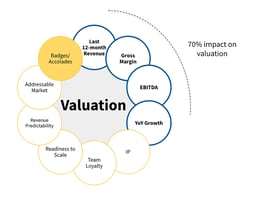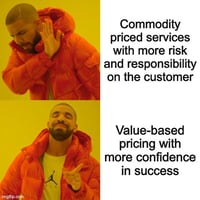We have already discussed the criticality of Revenue and Revenue Growth. They are primary drivers...
Planning Vs Wishful Thinking: A Reality Check Based On The Works Of John Boyd
In our July newsletter, we told you to expect articles on organizational planning. Organizational planning, like OKRs (Objective Key Results), turns your vision on a spreadsheet into reality through execution. This topic entails a lifetime of learning. But one of the best works I've seen that describes the underpinnings at play are the teachings of John Boyd. I do not consider myself a master at planning, execution, strategy, or John Boyd. But before opening the topic to help you initiate proper organizational planning in your tech services business, we want to share three lessons that will keep your plans from becoming wishful thinking.
This article is based on our readings of "Certain To Win: The Strategy Of John Boyd, Applied To Business" by Chet Richards and "Boyd: The Fighter Pilot Who Changed the Art of War" by Robert Coram. Organizational planning is a complex topic that encompasses culture, psychology, and leadership. We are starting the discussion with his writings because he is talking about the highly uncertain, high-achievement, high-stakes environment of war. And in that environment, he has distilled the essence of leadership into its most brutal basics without any attempt to sugar-coat or create a worldview other than the naked truth.
Difference Between Strategy And Plans

One of the key ideas by Boyd is the difference between a strategy and a plan. The two terms are often used interchangeably despite being very different. A plan is how to go from Point A to Point B. The reality is that your plan is most likely going to fail. You will Plan 2, 3, 4, 5. It is impossible to come up with the right plan beforehand. What you can come up with is a strategy.
A strategy is a system you use to create plans of action to reach your goals. It should be assumed that your plan is insufficient or incorrect and must be adjusted as you get new information. Your strategy will provide the guiding principles under which you change and adapt your plan. Often, we create one plan and call it a goal.
This is an indication that you are, in fact, engaged in wishful thinking, not strategy or planning. We are making a plan and assuming it will work. We need clear goals based on desired outcomes defining where we need to be, a plan to start the process, and an overarching guiding strategy to adapt or replace our plan.
Team Execution Or The OODA Loop
Boyd is most famous for the OODA loop. You can learn more about OODA from some of these excellent sources: HBR, Techtarget, The Strategy Bridge among many other great sources on the web. But I want to point out one thing. The OODA loop is a variation of the only process for learning. This loop is the same as the scientific process, where we incrementally increase our understanding of the world by using our current knowledge to create a hypothesis.
Test this hypothesis against reality. Look at the results and iterate with your new understanding. Boyd, Francis Bacon, Lean Manufacturing, Ibn Haitham. This idea underlies all rigorous thinking. For a team to execute in an environment with unknowns, they will need learnings. And so, they will need to run a variation of this loop. Your team's success is based on their ability to execute on this loop.
From Teams To Orgs
The framework of OODA governs how an execution team works. An organization consists of multiple teams running their respective OODA loops. Each of these teams needs to be successful in their aligned goals for the organization to succeed. The four key attributes of the Blitzkrieg identified by Boyd are less known but give you the tools to understand how the multiple objections come together. There are, as described in the book "Certain To Win":
-
Einheit: Mutual trust, unity, and cohesion
-
Fingerspitzengefühl: Intuitive feel, especially for complex and potentially chaotic situations
-
Auftragstaktik: Mission, generally considered as a contract between superior and subordinate
-
Schwerpunkt: Any concept that provides focus and direction to the operation
Seeing these attributes exhibited in a high-performing organization will help you understand how the individual team's actions come together in an organized manner to reach their goals.
It starts with mutual trust or Einhiet. Without that, there is no unified direction for the organization. There is no use to plan because no one will trust others. This trust is built with time in the crucible of your tech services startup.
The second concept of Fingerspitzengefühl is the intuitive ability of your leaders to make the right decision rapidly. This Fingerspitzengefühl, again, is going to be built with experience. Although, if you forgive me for inserting a plug for Vixul, A Vixul brain trust member can seed this in your organization. Both of these attributes are hard-earned. So you need to accept the current coherence on your team and slowly build competence.
Your org plan needs to have Auftragstaktik, the mission. The mission is not defined by the work that needs to be done. Instead, the mission is the goal that needs to be achieved. You may be familiar with this focus on the goal from Agile. When writing a user story, you talk about new capabilities provided to the user, not how to implement the work. The rest of the organization depends on each team to effectively perform the OODA loop to fulfill their mission and keep other parts apprised of changes. Just as important is the mutual agreement. Auftragstaktik is not just about ownership of the mission by having a voice in developing it. Einheit demands respecting that the team that is going to execute is closest to the problem and has the best understanding of the constraints in solving it. The leader needs to listen to the Fingerspitzengefühl of the execution team.
The team's autonomy goes beyond defining the mission and how to execute it. Schwerpunkt demands that every team understands the focus of the organization. This understanding of the focus gives them the autonomy to find opportunities to service and modify the mission while coordinating with the rest of the organization.
Conclusion
Reading this article has made you recognize that you cannot plan what will happen. In addition, you can recognize when the teams in your organization are empowered to act as a unit to complete their individual goals to service the organization's vision. We will talk about how to do the planning for your organization. This article establishes a starting point for your learning. Both a scaffolding on which you can build your leadership philosophy and a theoretical foundation to understand the forces at play when developing your nuts and bolts planning processes. We will share more on how to do the nuts and bolt planning, so please follow us on LinkedIn. In the meantime, prepare your targets to make sure you have something to plan for using our post "Guarding Against Down Quarters: KPIs For A Healthy Tech Services Sales Pipelines."
References:
-
"Certain To Win: The Strategy Of John Boyd, Applied To Business" by Chet Richards.




